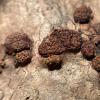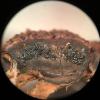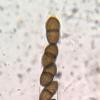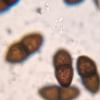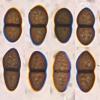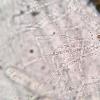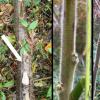
12-11-2025 09:25
 Viktorie Halasu
Viktorie Halasu
Hello, I need help with a pale terrestric Pseudom

11-11-2025 20:16
Bohan JiaHi, lastly I have found these tiny yellow decayin

09-11-2025 13:20
Hello.A tiny ascomycete, appearing as erupting gra

08-11-2025 00:29
 Francois Guay
Francois Guay
I found this species in Quebec, Canada, on herbace
I'm having trouble identifying a pyrenomycete I collected last week in New York City. I believe that the substrate is Rhus typhina, which was lying on the forest floor of a Bronx park.
The reddish stromata are erumpent through the bark of the substrate. The surface is quite wrinkled and quite deeply sulcate around the ostioles. The ostioles are black and most ejected a large blob of dark spores. The interior tissue is black. Perithecia are embedded at many different depths in the stroma with long necks. The tissue produces red pigments in KOH.
Asci are 123-134 x 11.8-12.5µm. They appear to be bitunicate, or if not, quite thick-walled. IKI-
Spores brown, 1-septate, constricted at the septa. For the most part, the two cells of the spores are equal in size. There appears to be a texture to the spores. Perhaps they are punctate, or maybe they are pitted? 15.5-19.9 x 6.9-9µm. Q= 2.2 N=20
Paraphyses (Pseudoparaphyses?) about 2.5µm wide.
Does anyone recognize this pyreno?
Thanks in advance.
Ethan


I agree with Jacques that aged Stromata of fulvopruinatum lose the yellow scurf and then mimick rubricosum. According to own observations fulvopruinatum is much more common at least in Europe , and this may be also the case in other temperate areas.
Concerning your collection I assume it is fulvopruinatum as the two small stromata clearly have a yellowish hue, a feature I haven't seen in rubricosum.
Best wishes Hermann


